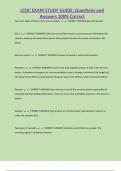Tentamen (uitwerkingen)
LCDC EXAM STUDY GUIDE; Questions and Answers 100% Correct
- Vak
- Instelling
LCDC EXAM STUDY GUIDE; Questions and Answers 100% Correct Two main types of cells in the nervous system CORRECT ANSWER-glia and neurons Glia CORRECT ANSWER-Cells that out number neurons, cannot process information like neurons, make up the blood brain barrier that protects the brain from toxi...
[Meer zien]



